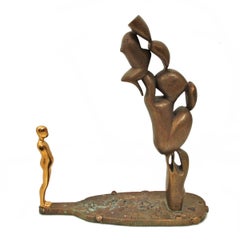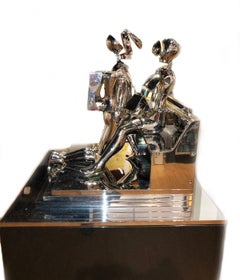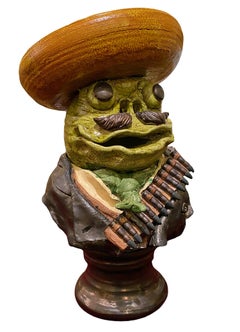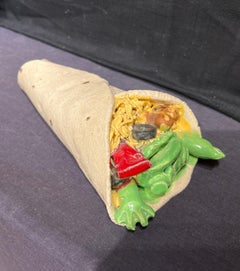Want more images or videos?
Request additional images or videos from the seller
1 of 5
Ernest Tino TrovaCar Man, Four Wheels
About the Item
- Creator:Ernest Tino Trova (1927 - 2009, American)
- Dimensions:Height: 17 in (43.18 cm)Width: 14.5 in (36.83 cm)Depth: 8 in (20.32 cm)
- Medium:
- Movement & Style:
- Period:
- Condition:
- Gallery Location:Missouri, MO
- Reference Number:1stDibs: LU74736680552
Ernest Tino Trova
Known for his Falling Man series in abstract figural sculpture, he created hard-edge images that brought him widespread attention because they seem to strike a chord of empathy with viewers who recognized themselves as human beings challenged by a technological society. Also, they are the only creatures aware of their mortality. He is considered highly innovative because of his successful combining of technological methods to create his art. Interpretation as to overall meanings vary with some thinking that it refers to the fall of man in the religious sense and others seeing it as a commentary on the tragic mechanization of society that reduces human beings. Trova has said that "falling" refers to the fact that man moves from one position to the next in an eventual fall to inevitable oblivion" (Kultermann 11). He has lived his entire life in St. Louis, Missouri although his reputation is nationwide. He did not think it necessary to study art because he believed in his own instincts, although he drew from a variety of sources including figurative painters such as Francis Bacon, Jean Dubuffet, and Willem DeKooning. The Falling Man series resulted from a unique offer from the Famous-Barr Department Store in St. Louis, where he had worked as a window decorator in his twenties. Store personnel told him that in exchange for creating a series of works to exhibit at the city's 1964 bicentennial celebration, he could have unlimited access to the store's materials and workers. The store's display department was a great setting for him to be creative with his interest in Pop Art, and this project gave him assembly-line assistance of carpenters, electricians, and painters. The result was that all images had Falling Man figures, and this included paintings, assemblages, collages, and movable sculpture, both electronic and hand driven. After the Bi-centennial, many of the pieces were then shipped to the Pace Gallery in New York City and received critical acclaim. Of his technique, he has explained that he first creates a cardboard model and then works from there, often making it life size. He is much more interested in variations of shape and form rather than color. Ernest Tino Trova died at his home in Richmond Heights, near St. Louis, Missouri on March 8, 2009 at the age of 82. (Obituary.New York Times March 13, 2009.)
About the Seller
5.0
Vetted Professional Seller
Every seller passes strict standards for authenticity and reliability
Established in 1970
1stDibs seller since 2017
156 sales on 1stDibs
Typical response time: Several days
Authenticity Guarantee
In the unlikely event there’s an issue with an item’s authenticity, contact us within 1 year for a full refund. DetailsMoney-Back Guarantee
If your item is not as described, is damaged in transit, or does not arrive, contact us within 7 days for a full refund. Details24-Hour Cancellation
You have a 24-hour grace period in which to reconsider your purchase, with no questions asked.Vetted Professional Sellers
Our world-class sellers must adhere to strict standards for service and quality, maintaining the integrity of our listings.Price-Match Guarantee
If you find that a seller listed the same item for a lower price elsewhere, we’ll match it.Trusted Global Delivery
Our best-in-class carrier network provides specialized shipping options worldwide, including custom delivery.You May Also Like
Bust Of A Young Woman bronze
By Kevin Berlin
Located in Lake Worth Beach, FL
Bust Of A Young Woman
Bronze sculpture signed by the artist inside the cast and dated 1988, 1st cast in London.
Kevin Berlin is an international arti...
Category
1980s American Modern Figurative Sculptures
Materials
Bronze
Bronze Bowl With Marble and Wood Sculpture
Located in Lake Worth Beach, FL
Bronze Marble Wood Sculpture
Four separate pieces, unsigned artist Sarah Schwartz was born 1953 Chicago, Illinois.
Education: 1971-72 York University/Ontario College of Art, Toronto...
Category
1980s American Modern Figurative Sculptures
Materials
Marble, Bronze
$1,250 Sale Price
50% Off
H 10 in W 16 in D 12.5 in
Modern Bronze Relic Sculpture of figure with 3 legs: 'Rhoman Fertility Goddess'
By Joshua Goode
Located in New York, NY
Inspired by amateur archaeologists such as Heinrich Schliemann who discovered Troy and by past elaborate hoaxes like that of the Piltdown Man, Joshua travels the world performing sta...
Category
2010s American Modern Figurative Sculptures
Materials
Bronze
$2,250
H 10 in W 9 in D 7 in
Renegade
By Brad Rude
Located in Bozeman, MT
Ed. 3/6
Artist Brad Rude was born in Montana and has lived in Walla Walla, Washington most of his life. His journeys through his grandfather's folk art st...
Category
2010s American Modern Figurative Sculptures
Materials
Bronze, Enamel
Combined Effort
By Brad Rude
Located in Bozeman, MT
Artist Brad Rude was born in Montana and has lived in Walla Walla, Washington most of his life. His journeys through his grandfather's folk art studio left...
Category
2010s American Modern Figurative Sculptures
Materials
Bronze, Enamel
Show of Interest
By Brad Rude
Located in Bozeman, MT
Artist Brad Rude was born in Montana and has lived in Walla Walla, Washington most of his life. His journeys through his grandfather's folk art studio left...
Category
2010s American Modern Figurative Sculptures
Materials
Bronze, Enamel
Arabesque, Female Ballet Dancer in Motion, Bronze Gray Bas Relief Sculpture Art
By Eric Bransby
Located in Denver, CO
This stunning figurative bas relief sculpture captures a female ballet dancer gracefully poised in the arabesque position, created by the acclaimed Colorado/Missouri artist Eric Bransby (1916-2020). Crafted from bronze and polymer Forton casting, the piece beautifully exemplifies Bransby’s mastery of motion and form.
Provenance:
Collection of the artist, Eric Bransby
About Eric Bransby:
Eric James Bransby was a highly respected muralist, painter, illustrator, and educator. His education at the Colorado Springs Fine Art Center included studies with renowned artists like Thomas Hart Benton, Jean Charlot, Boardman Robinson, and Josef Albers. He also studied at the prestigious Yale School of Fine Art.
Bransby’s career is defined by his exceptional work as a muralist, with notable commissions including the Rockhurst Library Triptych Mural at the University of Missouri, murals at Brigham Young University, the U.S. Air Force Academy...
Category
20th Century American Modern Figurative Sculptures
Materials
Bronze
$6,400 Sale Price
20% Off
H 40 in W 30 in D 3 in
Female Warrior
Located in New York, NY
A very unique bronze that touches upon the classic, female strength in form and the details beaux arts style in America. A work that really is for a collector and to be put in a spo...
Category
1910s American Modern Figurative Sculptures
Materials
Bronze
Mark Kostabi - Divine Embrace - Bronze Sculpture
By Mark Kostabi
Located in Winterswijk, NL
Mark Kostabi - Divine Embrace - Bronze sculpture
Divine Embrace is a unique bronze sculpture by renowned artist Mark Kostabi, featuring two faceless figures in an intimate embrace...
Category
21st Century and Contemporary American Modern Figurative Sculptures
Materials
Bronze
1961 Coty Award Plaque Kenneth Hairdresser Jacqueline Onassis Bronze Fashion
Located in New York, NY
1961 Coty Award Plaque Kenneth Hairdresser Jacqueline Onassis Bronze Fashion
Bronze on wood. The wood plaque measures 12 3/4" by 20 3/4 inches. The bronze plaque itself is 13 3/4 x 8 3/4 inches and the the bronze inscription, which reads "COTY, American Fashion Critics Special Award 1961 to KENNETH of LILY DACHE...
Category
1960s American Modern Figurative Sculptures
Materials
Bronze
More From This Seller
View AllFalling Man and Form
By Ernest Tino Trova
Located in Missouri, MO
Ernest Tino Trova
"Falling Man and Form" 1996
Brass and Bronze
14 x 4.5 x 4.5 inches
Signed and Numbered 1/1 (Unique)
Known for his Falling Man series in...
Category
1990s American Modern Figurative Sculptures
Materials
Brass, Bronze
Price Upon Request
The Encounter
By Ernest Trova
Located in Missouri, MO
Ernest Trova
"The Encounter" 1994
Chrome Plated Steel
Approx 24 x 26 x 24 inches
Edition 1/8
Known for his Falling Man series in abstract figural sculpture, he created hard-edge ima...
Category
1990s American Modern Figurative Sculptures
Materials
Stainless Steel
Price Upon Request
Emiliano Zapata / Frog Revolutionary
By David Gilhooly
Located in Missouri, MO
Emiliano Zapata / Frog Revolutionary, 1981
By David Gilhooly (1943-2013)
20" x 11.5"
Whimsical and irreverent, Mr. Gilhooly was internationally accla...
Category
20th Century American Modern Figurative Sculptures
Materials
Ceramic
Price Upon Request
Burrito Frog
By David Gilhooly
Located in Missouri, MO
Burrito Frog, 1981
By David Gilhooly (1943-2013)
8" x 4" x 2"
Signed Underneath
Whimsical and irreverent, Mr. Gilhooly was internationally acclaimed for his imaginative ceramic work...
Category
20th Century American Modern Still-life Sculptures
Materials
Ceramic
Price Upon Request
Frog and Swiss on Rye
By David Gilhooly
Located in Missouri, MO
Frog and Swiss on Rye, 1981
By David Gilhooly (1943-2013)
4.75" x 3.5" x 4.5"
Whimsical and irreverent, Mr. Gilhooly was internationally acclaimed for his imaginative ceramic works...
Category
20th Century American Modern Figurative Sculptures
Materials
Ceramic
Price Upon Request
Regina Enthroned
By Lazzaro Donati
Located in Missouri, MO
Lazzaro Donati (Italian 1926-1977)
"La Regina"
Bronze
Signed on Base
Size: approx 19 x 9 x 9 inches
Lazzaro Donati (1926-1977) was born in Florence in 1926 and attended the Academy of Fine Arts. He began to paint in 1953, and in 1955 held his first exhibition at the Indiano Gallery in Florence. Within three years eleven exhibitions followed in Italy, and as his reputation grew he was invited to give major exhibitions in London, Paris, New York, Chicago, Rio de Janeiro and Montevideo. He is considered one of the foremost contemporary Italian painters and his paintings hang in museums and private collections throughout the Americas, Europe and Asia.
Mr. Donati lived and worked at 24 Piazza Donatello in Florence, the square where generations of artists have created works worthy of the great Florentine tradition. As you entered the narrow hallway to his studio, a gilded life-size Venetian angel beckoned you to his door. Once inside, the present faded away and you found yourself in an atelier where early masters might have worked during the Renaissance. Within, luxurious Persian rugs set off the innumerable objects d'art and antique furnishings. Light poured in through the sloping glass wall on the north side. A dramatic stairway led to an overhanging balcony which served as a private gallery where the artist hung some of his favorite early works. To the left of the entrance was a smaller studio where Donati sculpted, with a window overlooking the famous old English cemetery where tourists laid flowers on the grave of Elizabeth Barrett Browning.
In the main studio itself, where Donati received his clients in an atmosphere as polished as an office of a top executive, one hardly realized that it was here that the artist actually painted. His easel was covered with Persian blue velvet, the painting on the easel was already framed, his chair was upholstered in red velvet and on his palette the colors were arranged with the precision of a Byzantine mosaic. In a corner stand were his latest works, framed and ready to be sent off to his next exhibition in Europe or America.
Donati was a born host with a warm welcome, an elegant man who possessed enormous charm a good nature and a keen sense of humor. Apparently shy, he preferred to speak on subjects extraneous to his art, purposely distracting you from his paintings, then leading you back to them, tactfully and without pretension. He spoke fluent French and English as well as some Spanish and German. "After all", he said, "you've got to know how to sell a painting to everyone."
He had no sympathy for the "drip and splash" studios of his contemporaries, preferring to keep his studio tidy and spotless. "Painting is a matter of precision", he said, "If a painter can't put his paint where he wants it to go, I don't see how he can call himself a painter. For me it is absolutely necessary to control the paint."
When asked to reveal the technique he used to achieve the enamel-like finish typical of his paintings he answered, "That is a secret between me and my butler. Actually, most of my paintings are done by him!"
But in fact behind the façade, Donati was a serious craftsman who devoted to his painting as a way of life and means of expression. From the beginning of his career, his paintings revealed a striving for perfection and continual research in problems of style and technique. His early works indicated a momentary interest in surrealism and abstract art; they were predominantly two dimensional, depending on line and strong color. But by 1958, with his painting The Lady with a Fan...
Category
Late 20th Century Modern Figurative Sculptures
Materials
Bronze
Price Upon Request
Recently Viewed
View AllMore Ways To Browse
Vintage Block Calendar
Vintage Camping Tents
Vintage Cancan Dancer
Vintage Fishing Trawler
Vintage Hockey Skates
Vintage Pony Express
Vintage Soccer Posters
Vintage Western Movie Posters
Volkswagen Poster
Warren W Sheppard
Wild Boar Painting
William Adolphus Knell
William Chadwick
William Muller
Writers Block
Xiao Li
Yayoi Kusama Skateboard
Yosemite National Park Paintings



